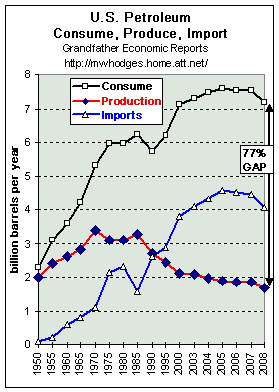 The chart shows >
The chart shows >U.S. oil consumption has climbed to near record high (black line on chart) - - to 7.2 billion barrels per year (20 million daily)
Grandfather
Economic Report series
Home & Contents | Summary | Feedback
| What's New
SUMMARY PAGE |
INTRODUCTION
We hear much about a looming Energy threat, but is it for real? The answer is emphatically YES!!
This summary, and the separate USA and World sections linked below, will tell you WHY.
A cheap and reliable supply of energy is the life-blood of America's economy, and the very basis of citizen living standards and national security.
Energy especially underpins our transportation and our food supply sectors, as well as our homes, work places, medical facilities, police and national security operations.
Yet, worryingly, America's per capita energy consumption increased during the 1990s, in spite of a declining US manufacturing base and despite importing more manufactured goods than ever before (i.e. produced by other nations using their own energy). And a rising population calls for more energy, not less.
For electricity, America can become self-sufficient since 76% is generated domestically from US-based coal (50%), nuclear (19%) and hydro-power (7%). However, excess reliance on natural gas (declining reserves and rising imports) and oil for electric generation, together with infrastructure and regulatory restraints, can undermine potential self-sufficiency.
But - transportation (auto, truck, aircraft, military), plastics and food energy demands are nearly 100% exclusively dependent on a predominance of oil, although USA-based oil reserves and production are declining - - causing a soaring dependence on foreign supply. (before 1950, including during World War II, America produced more oil than needed, even exporting to other nations. That comparative economic and national security advantage has disappeared).
Oil supply, therefore, represents America's main energy challenge into the future.
THE ENERGY CHALLENGE
IS MORE SO NOW
THAN EVER BEFORE
The world oil market daily produces 82 million barrels. (one barrel equals 42 gallons)
The United States, with 5% of the world's population,
daily consumes over 20 million barrels - - or 26% of the world's total.
And, America consumes 3 times more oil than it produces.
 The chart shows >
The chart shows >
U.S. oil consumption has climbed to near record high (black line on chart) - - to
7.2 billion barrels per year (20 million daily)
Meanwhile, U.S. oil production (red line on chart) declined to a 58-year low (since 1950 when America had 150 million fewer citizens) - - to just 1.7 billion barrels per year (4.6 million daily)
- - resulting in a 77% consumption-to-production gap
(inventory adjustments not shown)
- - requiring soaring imports from other nations (blue line on chart) - - while reserves of import supply sources decline.
Meanwhile, U.S. oil reserves are declining, with 4-10 years remaining if feasible to use every known drop
- - and no alternatives appear close to filling much of the increasing gap.
Additionally - - U.S. natural gas production has flattened, reserves are falling and imports are rising.
IMPORTANT > Take another look at the oil consumption (black curve) for 2008, noting a decrease for the first time in 23 years (since 1975) - - which was caused by huge oil/gasoline price increases plus a declining economy. Note also that domestic production (red curve) also declined faster, despite higher oil prices. As a result, the gap between production and consumption for 2008 actually increased to 77%, from 75% the prior year - - which means that despite lower imports due to lower consumption America's dependence on foreign oil actually increased - again!!
Note > 66% of U.S. oil imports (in 2008) were supplied by 6 countries (Canada 20%, Saudi Arabia 13%, Mexico 11%, Venezuela 9%, Nigeria 7% and Iraq 6%)
Consider this > With record trade deficits and declining manufacturing one would expect U.S. oil consumption to be steadily declining, since more and more goods consumed in the U.S. are created with energy from other nations. But, consumption continues at record levels. Additionally, average fuel efficiency in 2004 was 6% less than 20 years ago for personal autos and trucks. 50 years ago America produced half the world’s oil and was a net exporter of oil, yet today cannot produce even half its needs.
Analysts divide the oil producing world into two halves: OPEC and the rest. There is broad agreement that non-OPEC oil production will peak or at least plateau by about 2010. ExxonMobil chief executive Rex Tillerson said in 2007 that non-OPEC production growth would be all over in "two to three years".
"The country is facing serious energy shortages. Without a solution the energy crisis will threaten prosperity and national security and change the way Americans live." former U.S. Energy Secretary
While facing this Energy Challenge - -
and - - domestic debt ratios of household, business and financial sectors soar to
record highs, The U.S. may be more
vulnerable than ever. |
 - Citizens must be smarter than an
ostrich - Citizens must be smarter than an
ostrich about this ENERGY CHALLENGE - - because it will impact all of us. Above you
read the summary page of this Energy Report. 1. first read - - the USA
ENERGY section, where 8 powerful energy trend pictures are worth
a thousand words, helping you understand the big picture regarding the U.S. energy
challenge. |
The authors of the Grandfather Economic Energy Report, a chapter of
the Grandfather Economic Report series, are Michael Hodges (USA) and Jean
Laherrère (FRANCE).
Jean Laherrère (jean.laherrere@wanadoo.fr),
a retired French oil and gas explorer and geologist-geophysicist, has published
extensively regarding international energy resource and depletion research. Michael Hodges
(email), educated in physics and a retired business
executive, has developed extensive research regarding long term economic & education
trends in America as author of the Grandfather
Economic Report series. The authors have concerns regarding freedom and economic
conditions facing the generation of their children and grandchildren.
This Energy Report is a chapter of The Grandfather Economic Report, a series of picture reports showing threats to the economic future of families and their children, compared to prior generations - -on: family income, debt-dependence, savings, government spending and size, trust funds, education quality, social security, regulations, taxes, inflation, productivity, foreign trade and exchange, voter turnout, trust, celebration, national security, energy, and health care/life expectancy. It's a free, public service to enhance knowledge. You are now at the brief chapter on Energy supply, a significant threat facing our young generation. Welcome. We hope your visit will find useful information. Knowledge is Power, if you have it based on hard data..
Copyright © 1997-2011. Michael W. Hodges.
The Grandfather Economic Report series is
the intellectual property of its author; all rights reserved under Copyright Conventions.
Permission to redistribute all or part of this series for non commercial purposes is
granted by the author, provided the associated web page address (URL) is included and full
credit given to the Grandfather Economic Report and the author, Michael Hodges. Notice
appreciated via email.
TOP